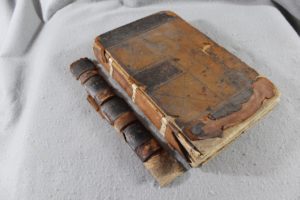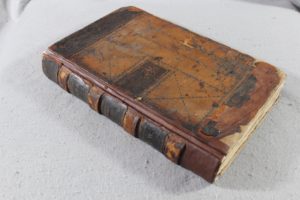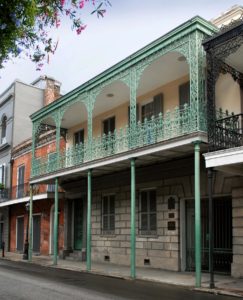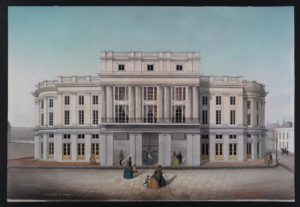Ledger of New Orleans Painter Joseph Benson Sheds Light on 1850s Building Materials
Katie Burlison,
Curator, Hermann-Grima + Gallier Historic Houses
In November 2018, The Decorative Arts Trust awarded the Hermann-Grima + Gallier Historic Houses (HGGHH) a grant for the conservation and digitization of a ledger that recorded the payments and deliveries of a variety of building materials in New Orleans dated 1849–1860.
The Gallier Residence (now part of the HGGHH) acquired what is known as the Benson Ledger in 1970. The brown leather-bound account book lists over 3,700 deliveries in the 1840s and 1850s (the most legible entries dating to 1859 and 1860) of paint, wallpaper, glass, and other materials to New Orleans residences and businesses. Kept primarily in storage over the past 50 years and presented to the public only on rare occasions, the volume’s fragile condition precludes the opportunity for regular study by researchers or HGGHH staff. The Trust-funded conservation and digitization project will allow institutions, scholars, and students from a range of disciplines access to this valuable resource.
Before conservation, the ledger’s spine covering was detached and partially lost, and many pages showed old stains and mold (Figure 1). Treatment by local conservator Beth Antoine of the New Orleans Book and Paper Lab included dry cleaning, removing the mold with soot sponges; reshaping, consolidating, and lining the spine; creating a new spine covering; reinforcing the boards and consolidating the leather; and mending flyleaves (Figure 2).
The next step, to be completed this summer, is to scan the ledger, transfer the images to an Open Source platform, and create a searchable index to the book’s entries. The digital version will be available for viewing on the HGGHH website and on an online archive, for both scholars and the public. The index of the ledger is derived from a handwritten version created in 1973 by Tulane University architecture student Paula Madden.
The ledger records deliveries made by English-born brothers, Joseph (c. 1819–1860) and John Benson (c. 1823–1867). Beginning in 1848, they were listed separately as painters in New Orleans city directories. In 1851, “J. Benson” offered house, sign, and ornamental painting, and painting in imitation of wood and marble. From 1853 to 1855, only Joseph Benson is listed at 132 Camp Street. John appears again in 1856, and the brothers are listed together until 1860 (Figure 3).
In 1856, the brothers advertised themselves as “makers of Plain and Ornamental Copper and Zink Sash, for Churches or Fancy Cottages, and glazed with plain, figured, or stained glass. The Sash is very strong and cheap, and can be seen in use at St. Paul’s, St. Patrick’s, Baptist, Clapp’s and St. Joseph’s Churches, all in this city.” Indeed, a few months earlier, the editors of the Semi-Weekly Creole praised their skills : “By their fidelity and promptness in business, the Bensons have secured the patronage of our most influential citizens. They have painted the principal churches of this city and given universal satisfaction.”
Initial examination of the ledger and its contents has revealed a plethora of well-known surnames and locations receiving deliveries from the Benson Brothers, including Dufour, Forstall, Miltenberger, Trinity and St. Patrick’s Churches, the French Opera House, and luxury goods retailers Hyde & Goodrich. Among the most common materials are paint, zinc sashes, wallpaper, and glass. The Bensons delivered supplies to architects and builders including Henry Howard, one of Louisiana’s most prominent 19th-century architects, and Samuel Stewart, who was responsible for the erection of the Pontalba Buildings on New Orleans’ Jackson Square. The brothers supplied private residences, shops, stables, churches, and asylums with window glass and sashes, signs, paint, shellac, varnish, and “Japan;” and painted all kinds of buildings in a variety of materials and techniques. Joseph Benson endorsed Bridgewater Paint in 1852, certifying that he had used the paints “on brick and plastered buildings, and on tin, shingle and canvas roofs” and claiming the paint possessed “qualities that particularly recommend it for use in a Southern climate.”
On 20 separate dates the Bensons supplied materials to New Orleans architect James Gallier Jr. for his family home on Royal Street (now the Gallier Historic House). These deliveries included “turps” (oil of turpentine), lead, zinc, thinners, dryers, and paint in Paris Green, raw sienna, Prussian Blue, burnt umber, and vermillion (Figure 4). Gallier chose the color Paris Green for the wrought- and cast-iron balconies, columns, and gates on the front façade of the house (Figure 5).
Under the direction of James Gallier Jr. and his partner, Richard Esterbrook, Joseph Benson supervised the painting of the French Opera House at the corner of Toulouse and Bourbon Streets in 1859 (Figure 6). The firm of Gallier & Esterbrook, which was one of the Benson’s top clients, received several hundred deliveries for this single project, such as glass, skylights, blinds, sash, and items destined for the Opera’s Club Room and Bar Room (Figure 7). As described in The Sunday Delta on the eve of the Opera House’s opening, the auditorium’s décor included a full Corinthian entablature on four fluted Corinthian columns; gilded capitals, shaft-mouldings, and column bases; pedestals painted and veined to imitate marble; and ornaments stamped in zinc and gilt decorating the four tiers of galleries. Gallier and Esterbrook endeavored to erect a building that “should combine elegance and simplicity with the greatest degree of comfort possible.”
The Benson Ledger comprises a wealth of information about the Antebellum artists and patrons of New Orleans, including their choice of paint colors and materials, among other architectural insights. Digitizing this significant historical document will provide access to scholars, students, conservators, and historians, and will protect this important historical object from future deterioration.
1 Semi-Weekly Creole, April 19, 1856.
2 Semi-Weekly Creole, February 16, 1856, p. 2 col. 1.
3 The New Orleans Daily Crescent, April 6, 1852, p. 4 col. 4.
4 The Sunday Delta, December 4, 1859, p. 4, col. 1–3.
Updates:
- View the ledger at https://archive.org/details/
BensonLedger. - Edits were made to this online article to reflect records that show Joseph was born in Manchester in 1819 and died in New Orleans in 1860 and that John was born in Manchester in 1823 and died in Manchester in 1867.







